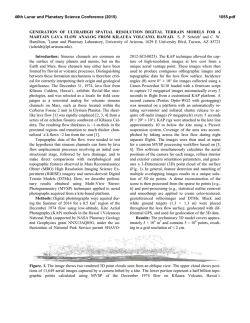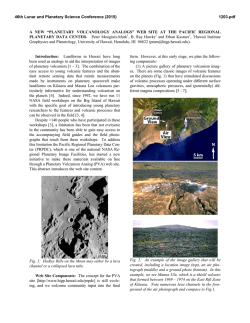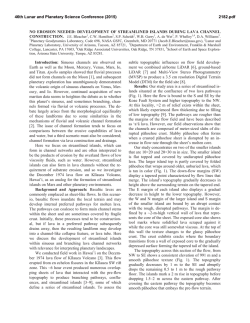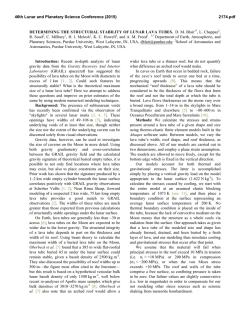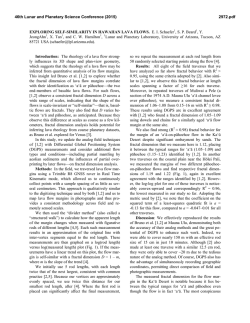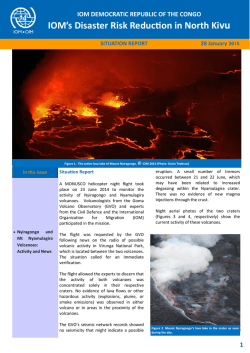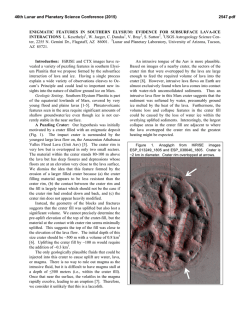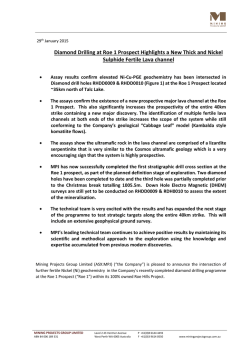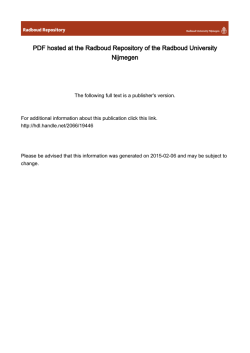
EROSION BY LAVA ON THE MOON: APPLICATION TO THE RILLE
46th Lunar and Planetary Science Conference (2015) 1582.pdf EROSION BY LAVA ON THE MOON: APPLICATION TO THE RILLE OF VALLIS SCHRÖTERI. Vincenzo Cataldo1, David A. Williams1, and W. Brent Garry2 1School of Earth and Space Exploration, Arizona State University, Tempe, Arizona, 85287-1404 ([email protected]); 2Planetary Geodynamics Laboratory, NASA Goddard Space Flight Center, Greenbelt, MD. Introduction: Erosion by lava has been suggested to have played a role in the formation of some lunar sinuous rilles [1,2,3]. The process would involve some combination of thermal erosion (i.e., melting of the substrate) and mechanical erosion (i.e., physical removal of unconsolidated substrate without melting). Regardless of the mechanism, erosion by lava is likely to have a role for high-temperature, low-viscosity lavas, which are likely to flow turbulently [1,2]. Vallis Schröteri is the largest sinuous rille on the Moon, and includes an outer primary rille that stretches out to a distance of ~150 km from the lava source, and a meandering inner rille that extends ~50 km farther downstream. Here, we focus on the formation of the primary rille. The rille sits atop the Aristarchus Plateau, a block of ancient highland crust that was uplifted during formation of the Imbrium basin, and slopes away from it, to the west [4]. The path of the rille may have been influenced by the exploitation of pre-existing tectonic features and topography [4]. Subsequent meteoritic bombardment created a several-meter-thick regolith, which is stratigraphically overlain by basaltic material cropping out in the upper walls of the rille, and ironrich pyroclastics [5,6]. Highland material is only exposed at the head of Vallis Schröteri [4]. Clementine data shows that low-titanium basalts characterize this portion of the plateau [7]. The composition of the lava substrate is similar to that of the upper anorthositic crust, since the Moon Mineralogy Mapper (M3) detected abundant feldspar and a lack of mafic silicates in the central peaks of Aristarchus crater [8]. There is disagreement as to the exact dimensions of the rille [9,10]. Our objectives are: 1) derive an estimate of the thickness of the basaltic layers outcropping in the rille walls; and 2) investigate the role played by erosion by turbulent lava by adapting the Williams et al. [11] model to the geology of the area. Rille topography and lava thicknesses: We made use of available Lunar Reconnaissance Orbiter (LRO) Wide Angle (WAC) and Narrow Angle (NAC) Camera images of the rille, in which the NAC images have a higher spatial resolution of ~30-50 cm/pixel [12]. The Lunar Orbiter Laser Altimeter (LOLA) aboard LRO enabled determination of rille slope and depth. Data collection was facilitated by the use of the ArcGISTM software, which enables creation of stacks of individual image layers. Lava layers cropping out in rille wall sections that trend E-W were recognized in available NAC stamps and footprints, and enabled derivation of first-order estimates of lava thickness by simple trigonometry. From these, lower-end volume estimates were obtained and used to constrain minimum flow durations and erosion depths by the Williams et al. model. The Williams et al. model: This rigorous analytical-numerical model calculates erosion rates and depths with time, as a function of distance from the lava source. The flow is one-dimensional in the horizontal direction, with thermal erosion in the vertical direction. Lava erupts as a turbulent flow with a thermally mixed interior, and convective heat transfer occurs to the top and base of the flow. The model accounts for the effects of lava rheology changes due to assimilation of eroded substrate and crystallization of mafic minerals; the lava temperature decreases as the flow moves downstream; flow thickness increases as velocity decreases (thickness is used as proxy for flow rate that is conserved). Key input parameters of the model include: 1) lava and substrate compositions; 2) lava thickness; 3) substrate slope. The composition of the lava is assumed to be equal to that of the lunar lowtitanium picritic basalt sample 12002 [13], whereas the substrate is assumed to have the composition of a “pure” ferroan anorthosite (PFA) [14]. The substrate is modeled as: a) consolidated; b) partly consolidated. Case b) is simulated by assuming that only some fraction of the heat of fusion (fL) is required to remove low-melting temperature materials from the substrate, and the remaining materials could become incorporated into the lava through mechanical erosion [1]. A value of fL=100% applies to a consolidated substrate, whereas fL= 40% if it is partly consolidated. Lava thicknesses and substrate slopes are shown within the results section. The model outputs decreasing flow velocities and increasing flow thicknesses, which are multiplied by rille width to provide 3-D flow rates. From these, minimum and maximum flow durations are obtained by using volumes calculated for the outcropping lava layers, and the entire rille. Results – Rille dimensions: The average width of the rille is ~5 km, although it varies from ~10 km (cobra head) to ~2.8 km at the rille terminus. The depth is in the range 700-550 m at the cobra head and progressively decreases from ~650 to ~500 m, out to the terminus. The average slope of the ground is equal to ~0.2° within 60 km of the rille source, and decreases to ~0.1° out to the rille end. The thickness of individual lava layers varies from less than 5 m to ~20 m, and total thicknesses are in the range ~70-150 m. These 46th Lunar and Planetary Science Conference (2015) 1582.pdf values are consistent with those observed by the Apollo 15 crew at Hadley Rille [15]. Results – Modelled erosion depths: Table 1 shows average flow parameters as a function of flow rates and thickness for an eruption temperature of 1440° C (liquidus) and a slope of the ground of 0.14°. h m uav m/s µav Pa s Reav # Q km3/s ta tb 5 10 15 20 1.8 3.1 4.1 5.0 4.8 1.2 0.8 0.6 4.7x104 1.6x105 3.5x105 6.0x105 5.3x10-5 1.6x10-4 3.2x10-4 5.1x10-4 23.5 7.5 3.9 2.4 82.3 26.4 13.6 8.5 Table 1: Average flow parameters for four values of lava thickness and lower to upper end lava volumes. Here, h is lava thickness, uav is flow velocity, µav is bulk viscosity, Reav is Reynolds number, Q is effusion rate, ta is flow duration if V = 110 km3 (volume of thickest layer sequence observed in the walls), tb is flow duration if V = 375 km3 (total rille volume). Flow conditions are turbulent across the entire length of the rille, due to very low bulk viscosities that never exceed ~5 Pa s. Effusion rates vary by ~ an order of magnitude for flows ranging 5 to 20 m in thickness, and flow durations of ~2 to 82 days are obtained from volume estimates of the wall basaltic layers (up to 110 km3) and the entire rille (375 km3), respectively. Eruption duration is necessarily approximate since effusion rate is expected to vary with time. Erosion rates are always higher at the source and increase with lava thickness, and for a partly consolidated substrate (fL=40%). Figure 1 shows how maximum erosion depths vary within 60 km of the source for fL=100% and fL = 40%. The flow durations associated with these erosion depths are shown in the tb column of Table 1. Figure 1: Erosion depths plotted against a 60-kmdistance from lava source, for three values of lava thickness. The rate of consolidation of the lava substrate decreases as fL decreases from 100% to 40%. Values of ~46 m are obtained at the source where the lava is hotter and fully turbulent (Re ~105) (Fig. 1). Figure 2: Erosion depths plotted against downstream distances of 60-150 km. The smaller depths of erosion are due to the lower values of slope of the ground (0.1°) and Reynolds number of the flow. Figure 2 shows how a slightly lower slope of the ground (0.1°) impacts erosion depths. The value of ~15 m is a factor of 3 lower than that obtained at the rille source. Differences in erosion depths at upstream and downstream locations are progressively reduced as flow thickness increases, as shown in both figures. The greatest value of erosion depth (~46 m) is ~1.1-1.6 orders of magnitude smaller than the depth of the rille. As a result, thermal erosion does not appear to have had an important role in the formation of the outer primary rille of Vallis Schröteri. Discussion: The emplacement of superheated lavas could have produced a higher rate of thermal erosion on the Moon, since lava temperatures could have been up to 200° C above their liquidi [11]. Moreover, elements from available mechanical/thermo-mechanical models of erosion by lava could be incorporated into an advanced version of the model to estimate the extent to which this mechanism could have excavated the rille. Nevertheless, tectonics likely contributed to the shape of the rille as we see it now. References: [1] Hulme, G. (1973) Mod. Geol., 4, 107-117. [2] Carr, M. H. (1974) Icarus, 22, 1-23. [3] Greeley, R. et al. (1971) Science, 172, 722-725. [4] Zisk, S. H. et al. (1977) Moon, 17, 59-99. [5] McEwen, A. S. et al. (1994) Science, 266, 1858-1862. [6] Campbell, B. A. et al. (2008) Geology, 36, 135-138. [7] Zhang, F. et al. (2014) Icarus, 227, 132-151. [8] Mustard, J. F. et al. (2011) J. Geophys. Res., 116, E00G12, 2-17. [9] Garry, W. B. et al. (2008) LPS XXXIX, Abstract # 2261. [10] Honda, C. et al. (2009) LPS XL, Abstract # 1524. [11] Williams, D. A. et al. (2000) J. Geophys. Res., 105, 20189-20205. [12] Robinson, M. S. et al. (2010) Space Sci. Rev., 150, 81-124. [13] Walker, D. et al. (1976) Geol. Soc. Am. Bull., 87, 646656. [14] Warren, P. H. (1990) Am. Miner., 75, 46-58. [15] Spudis, P. D. et al. (1987) Proc. LPS XVIII, 243254.
© Copyright 2025
